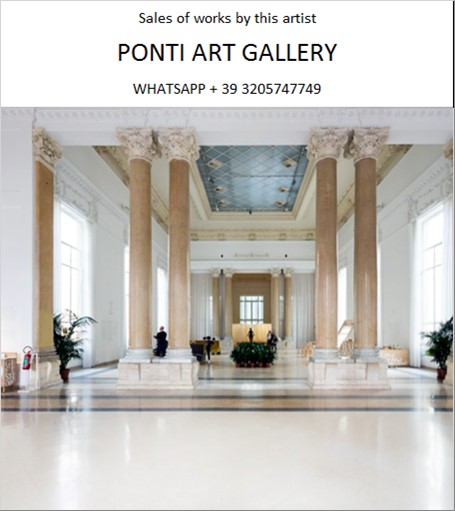Ponti Art Gallery is interested in buying and selling works
of art by this artist.

Gillo Dorfles Biography
Gillo Dorfles was a towering figure in the world of art criticism, painting, and philosophy, whose career spanned much of the 20th century and extended into the 21st. Born Angelo Eugenio Dorfles on April 12, 1910, in Trieste, Italy, he was a man of diverse interests and talents, whose work left an indelible mark on the fields of aesthetics and contemporary art.
Dorfles' early life was marked by a rigorous academic pursuit; he graduated in medicine from the University of Milan in 1936, specializing in psychiatry. However, his passion for art was too strong to be sidelined, and it eventually led him to pursue a career as an art critic and theorist. This decision would shape the Italian art scene and contribute significantly to the understanding of avant-garde movements.
In 1948, Dorfles was among the founders of the Movimento Arte Concreta (MAC), a group that promoted non-figurative art, specifically a form of geometric abstraction. Alongside artists such as Atanasio Soldati, Bruno Munari, and Gianni Monnet, he sought to explore and establish new artistic paradigms. His involvement with MAC was complemented by his co-founding of the Associazione per il Disegno Industriale (ADI) in 1956, which aimed to promote industrial design.
Dorfles' work as an art critic was characterized by an interdisciplinary approach that wove together philosophy, sociology, and psychology. He believed that art should be reflective of the cultural and social context in which it was created. His writings often delved into the relationship between art and industry, the avant-garde, and the phenomenon of taste in contemporary society. He was a visionary who navigated the ever-changing landscape of contemporary art, inspiring generations with his profound insights and unyielding passion for artistic expression.
His contributions to literature on art and aesthetics are numerous and influential. Among his major works are "L'architettura moderna" (1954), "Kitsch: The World of Bad Taste" (1968), "La moda della moda" (1984), "Il feticcio quotidiano" (1988), and "Horror pleni. La (in)civiltà del rumore" (2008). These texts explored various themes from the aesthetics of industrial design to the cultural implications of kitsch and bad taste.
Dorfles' own artistic production was significant as well. His paintings were exhibited in various personal exhibitions, including those held in Milan in 1949 and 1950, as well as in numerous collective exhibitions with MAC. Even as he delved deeper into art criticism, he continued to hold personal exhibitions, such as those in Milan in 1986, Aosta in 1988, and Rome in 1996. His work often veered towards surrealism, and he returned to his fantastical character of Vitriol in his later years, which was exhibited as part of the Milan Triennale in 2017.
Despite his critical and theoretical work, Dorfles never abandoned painting, which remained a constant part of his life. His output, in qualitative terms, reached an acknowledged and established level, and he never ceased his continual research and development as a visionary artist. His Vitriol drawings, exhibited as recently as 2017, represent the latest stage in his development.
Dorfles' eclecticism was a hallmark of his approach to art and life. He was known for having an open mind and for engaging with the most up-to-the-minute styles and languages without sacrificing his own identity or shying away from unique intellectual adventures. His studies on Kitsch have become an international benchmark, and his work for Caimi as a designer of Snowsound Art sound-absorbing panels in 2017 showcased his ability to transform function into an accessible art gallery.
Throughout his career, Dorfles was a proponent of artistic experimentation and openness to new forms of expression. He embraced a broad range of artistic styles and movements, advocating for the importance of individual creativity and innovation in art. His teaching career was equally distinguished, with positions in aesthetics at the Universities of Milan, Cagliari, and Trieste.
Dorfles' longevity was remarkable; he lived to be 107 years old, passing away on March 2, 2018, in Milan, Italy. His life and work were celebrated through various exhibitions and publications, and his centenary was marked by significant retrospectives. Even in his later years, he continued to work and contribute to the discourse on art, reflecting his lifelong passion and dedication to the field.
Gillo Dorfles' legacy is that of a man who lived art in all its forms, who influenced and shaped the understanding of contemporary aesthetics, and whose work continues to inspire and provoke thought in the realms of art, design, and architecture. His profound impact on the cultural landscape of the 20th and early 21st centuries ensures that his name will be remembered and revered for generations to come.
Gillo Dorfles Quotes and Sales
of Works
Ponti Art Gallery selects and deals with paintings by the
artist. Upon request, we provide free estimates and
evaluations, communicate prices, quotations, and current
market values.
If you are interested in BUYING or SELLING works by the
artist, contact us immediately.
If you wish to sell or receive an evaluation of the
works:
Send us a frontal photo of the painting, one of the back,
and one of the signature. Also, indicate the dimensions of
the work. Inform us about the purchase origin of the work
and any kind of available documentation (purchase
receipts, certificates of authenticity, publications). One
of our operators will respond to you on the same day. We
guarantee maximum confidentiality and extreme
professionalism.
If you wish to purchase works by the painter: Contact us
and let us know your request. We will inform you about the
available works. We also offer the possibility to
subscribe to our NEWSLETTER, through which you will be
informed at the beginning of each month about the latest
acquisitions of the art gallery.
You can send us pictures of the work:
